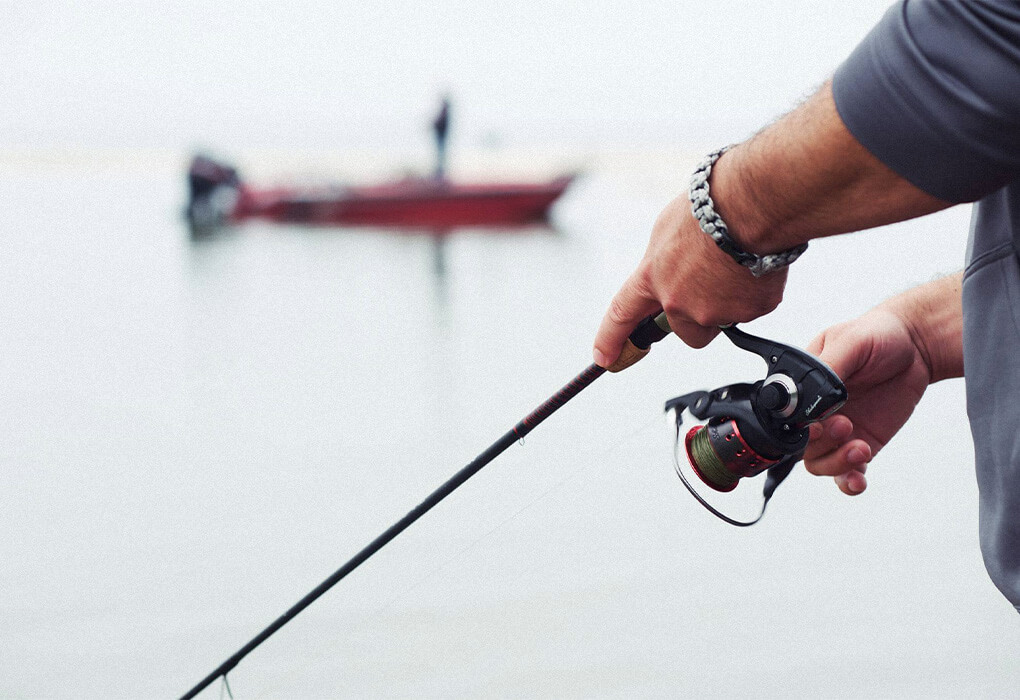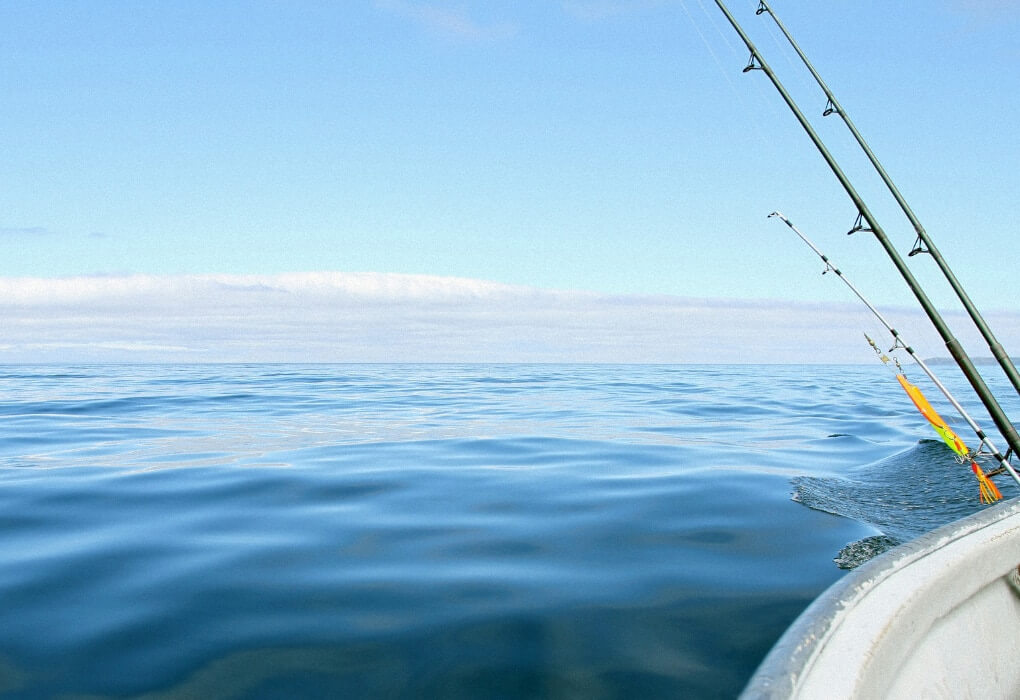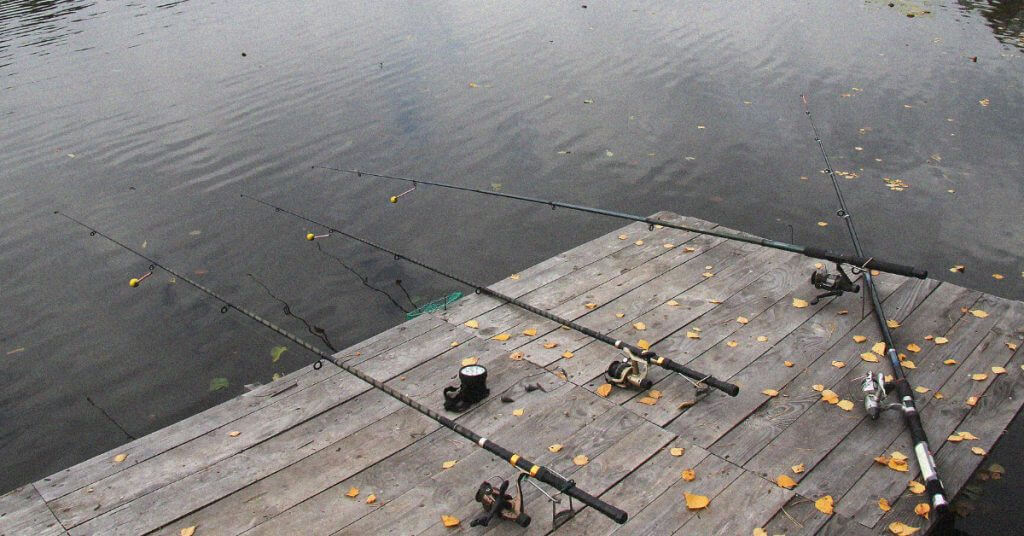If you want to catch fish successfully without snapping your rod in half, you need to select a rod with the correct power rating. A power rating describes the rod’s ability to stay stiff and not bend.
Fishing rods come in several power ratings, ranging from ultra-light to extra-heavy. Generally speaking, fishing rod manufacturers all use the same rating system.
However, there can be slight variances from one company to another, especially regarding “in-between” ratings like medium-heavy. There isn’t a consistent rating system across all companies.
Therefore, considerations like getting a medium vs medium heavy rod are more complicated than they may first appear.
Furthermore, exactly what each power is best for can be a topic of contention. Sometimes, a power rating is better for a certain technique or type of fish. Other times? Not so much.
Below, we’ll review exactly what a power rating is and help you determine the power rating of a rod you’re interested in. We’ll also look at when to use a medium rod vs. a medium-heavy rod.
Table of Contents
What Rod Power Really Means
Rod power describes how much weight it takes for the rod to start bending. It isn’t necessarily a measurement of how much weight a rod can take before it snaps in half or what size fish it can handle.
A rod’s power is often described as the rod’s “backbone” as well. These terms are utilized almost interchangeably.
However, power completely differs from a rod’s “action,” where the rod bends. For instance, a fast-action rod bends towards the tip, while a moderate action bends in the top half.
As we stated previously, there is no consistent unit of power measurement between manufacturers. Instead, the power rating is often only useful when comparing rods of the same company.
For instance, a medium-heavy Ugly Stik rod requires more weight than a medium Ugly Stik rod to bend. However, the same thing isn’t necessarily true if you compare it to a rod from a different company.

Therefore, most companies also use lure weight and line test to describe the rod’s power.
If you want an accurate description of a rod’s power, you’ll want to look at both metrics. I’ve always found that the metrics are far more accurate than the power label.
Lure Weight
Lure weight on a fishing rod refers to the weight range of fishing lures that the rod is designed to handle effectively.
It is an important factor to consider when selecting a fishing rod, as using too heavy or too light lures for the rod can result in poor casting distance, accuracy, and control and may even damage the rod.
Lure weight is typically indicated on the rod blank or handle. It is usually expressed as a range of ounces.
For example, a rod with a lure weight range of 1/4 – 1 ounce can effectively handle lures weighing between 1/4 and 1 ounce.
Line Test

In the context of a fishing rod, a line test refers to the recommended range of fishing line strengths that the rod is designed to handle effectively.
Always look at the line test when selecting a fishing rod, as using a line that is too light or too heavy for the rod can result in poor casting performance and reduced sensitivity.
You may even damage the rod if it’s used with the incorrect line.
The line test of a fishing rod is usually indicated on the rod blank or handle and is typically presented as a range. For example, a spinning rod with a line test of 6-12 lb is designed to handle fishing lines that are within the 6-12 lb range.
You’ll need a higher line test for larger fish or fishing in heavy cover. If you’re fishing for smaller fish or clear water, a lower line test range is typically best.
Bigger isn’t typically better, in this case.
Differences Between Medium and Medium-Heavy Rods
| Medium Rod Uses | Medium-Heavy Rod Uses |
| Finesse techniques like wacky rigging, shaky head, and drop shotting | Heavier fishing techniques like pitching, flipping, and punching |
| Medium-sized fish like trout, panfish, and bass | Larger fish like pike, bass, catfish, and musky |
| Suitable for clear water with light cover | Suitable for heavy weed cover |
| Medium-sized lures like spinnerbaits, jigs, and crankbaits | Best for larger baits like swimbaits, topwaters, and jerkbaits |
| Can be utilized for saltwater fishing |
Medium Rod Uses
Anything that requires finesse and sensitivity may call for a medium rod. These rods are much more powerful than light options but are still unsuitable for larger fish species.
You can use medium rods in many situations, including trolling, bottom fishing, and casting lures. You can also use them with topwaters, soft plastics, and spinnerbaits.
Because they’re in the middle of the power scale, these rods are often considered “generalists.”
I recommend these rods for the following situations:
Light Cover
These rods cannot handle heavy weed coverage. Therefore, they’re best for angling in open water when you don’t need to pull the fish through a wall of weeds.
Light weed coverage is fine, but you’ll need something stronger if you go beyond that.
I tend to upgrade my rod as the summer goes on, as the weed growth tends to get bad in the summer in my area. Medium rods work in open water, but that’s about it.
Small- to Medium- Fish
This rod can handle sizable fish. However, it cannot handle the biggest fish. Therefore, you must upgrade to a stouter rod to hook monster bass or larger saltwater fish.
Generally, medium rods can handle line weights between 6-12 pounds. It can vary between companies, so always check for details before purchasing.
Rod powers are a bit like clothing sizes. In my experience, the rod power can be a bit vague.
Here’s a list of fish medium-power rods are suited for:
- Trout
- Largemouth and smallmouth Bass
- Walleye
- Redfish
- Snook
- Speckled trout
- Snapper
- Grouper
- And others
Finesse Techniques

Techniques that require sensitivity are performed well by a medium rod. Medium-heavy rods are often too stout for these techniques.
For instance, wacky rigging with larger baits like senkos often utilizes medium rods. You can also perform drop shotting and shaky head with a medium rod.
A rod with a fast or extra-fast action is ideal for finesse fishing as it allows for greater sensitivity and control. A fast action rod will have a stiffer tip section, allowing for better hooksets and the ability to detect even the slightest bites.
Additionally, a fast action rod will have a more powerful backbone, which is important when fighting larger fish on light line.
Smaller Bodies of Water
Fish in smaller bodies of freshwater tend to be on the smaller side. Therefore, a medium rod often has enough backbone to handle just about anything in these smaller lakes.
Medium-light rods sometimes work well in this situation, too. There is a little reason to drag out a bigger rod.
Plus, the smaller rod often provides more accuracy, allowing you to hit smaller targets. You’re giving up a bit of range, but this doesn’t typically matter when in a smaller body of water.
When You Don’t Know What You’re Getting
Medium rods are extremely versatile. They’re in the middle of the rod power range, so they aren’t particularly light or heavy.
They’re a great option when you don’t know what you’re getting into. They’re good for beginners who also want to purchase a single rod.
Showing up to a situation with a medium rod when you need a light rod is challenging, but it isn’t impossible. However, showing up with a heavy rod when you need a light one creates a practically impossible situation.
Sticking with a rod closer to the middle is the way to go when you don’t know what to expect.
Pros:
- Versatile and an all-around solid choice
- Flexible for use with light and medium lures
- Sensitive enough for use with finesse techniques
- Easier to control (especially if you’re a smaller person like me)
- Easily available at practically any tackle shop
Cons:
- Lower casting distance due to a lack of power
- Cannot handle larger fish
- Less sensitive than light rods, so they’re not as suitable for all finesse techniques
- Not always suitable for specific techniques like trolling
- Reduced control over larger fish, making them harder to bring in
Medium-Heavy Rod Uses
Medium-heavy rods are often used for larger fish. They’re more powerful and have a stronger backbone, which helps them handle bigger fish.
They’re somewhere in the middle of medium rods and heavy rods. However, exactly what counts as “medium-heavy” varies.
These rods are less versatile than a medium rod. They’re particularly useful for certain techniques, like baitcasting.
That said, there are several situations that may call for using this rod:
Heavy Weed Coverage

When you’re fishing in an area with heavy cover, you need a strong rod to pull the fish through the underwater jungle. You may need to upgrade your rod to a medium-heavy option – even if you’re still targeting smaller fish.
In my experience, many shallow lakes will have thick cover by the end of summer. Even if you used a lighter rod in the spring, you might need a more powerful one in the summer.
With that said, it can depend on the pH of the lake.
Having a medium-heavy rod on hand can be handy just in case you discover the area has thicker coverage than you were originally expecting.
Larger Fish
If you’re targeting larger fish, you need a more powerful rod. Here’s a short list of species commonly targeted with a medium-heavy rod:
- Bass
- Pike
- Musky
- Catfish
- Walleye
- Snook
- Redfish
Bass are a bit of a complicated species. When asking whether to get a medium or medium heavy rod for bass fishing, it depends on the size of the bass you’re planning on encountering.
Heavier Lures
Medium rods cannot handle larger lures, so you may need to upgrade to a medium-heavy for certain techniques, like swimbaits. Heavier jigs and spinnerbaits also require a medium-heavy rod.
Rods are often given a lure weight rating, which describes the exact weight lure the rod can be used with. Be sure to double-check this rating if you want to use a specific lure.
Stronger Currents
Many anglers will tell you medium rods can be used in stronger currents. However, I find that medium heavy rods are easier to use whenever the current starts picking up.
The extra backbone of a medium heavy rod makes it much easier to fight the current and any potential fish that comes along. You may also retain some sensitivity, which other rods tend to lose in strong currents.
Saltwater Fishing

In both inshore and nearshore environments, I recommend medium-heavy rods. These rods have enough power to handle the common saltwater species, like speckled trout and snook.
That said, in the medium vs medium heavy rod saltwater debate, there isn’t necessarily always a clear winner, especially when you’re inshore.
Pros
- Stronger to handle bigger fish
- Higher power maximizes control when fighting a fish
- Versatile enough to use with several different techniques
- More sensitive than heavy rods, so they can be used for some finesse techniques
- Durable thanks to their stronger construction
- Powerful backbone increases casting distance, especially since these rods tend to be longer
- Performs better when hooksets are important
Cons:
- Less sensitive than medium rods, preventing you from feeling all nibbles and bumps
- More challenging to use for finesse techniques
- Heavier, making them more challenging to use
- Often more expensive than less powerful rods
FAQ
What is a medium heavy rod good for?
Medium heavy rods are good for targeting larger fish, like bass, pike, and trout. They’re able to troll at higher speeds than lighter rods, as well.
Their larger size can also make it easier to control fish when fighting them.
How big of a fish can a medium heavy rod handle?
A medium heavy rod can usually handle a fish between 8 and 25 pounds. However, the exact weight can vary from company to company.
Usually, the line test range is listed on the rod handle, giving you a more accurate picture of how much weight that rod can handle.
What is the best weight range for a medium heavy rod?
The best weight range depends on the fish you’re targeting. You want a rod that can handle whatever you plan to catch, which can differ depending on the species.
Most medium heavy rods range between 8 and 25 pounds, but different companies have different weight ratings.
What does a medium heavy rod mean?
A medium heavy rod is one with a medium heavy power rating. Exactly what that means depends on the company, as there is no standard rating system.
Conclusion
Whether you need a medium or medium heavy rod depends on where you’re fishing, what you’re fishing, and how you’re fishing.
You want a rod that can handle the size of the fish you plan on catching. You need a bigger rod if you’re going after a bigger fish.
Weed coverage and the size of the body of water also affects which rod you need. A medium heavy rod is often necessary for heavy weed coverage.
Finesse techniques require a lot of sensitivity, and lighter rods tend to be the most sensitive. However, some techniques that require heavy lures may need more powerful rods to be done successfully.
In the end, when choosing between a medium vs medium heavy rod, it’s important to consider your preferences and situation. One rod power isn’t necessarily better than any other.
What power rod is your favorite? Let us know in the comments below.




